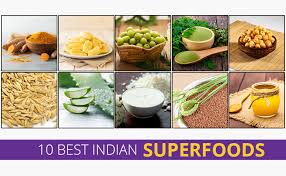Long before the term “superfood” became popular worldwide, Indian households were already using ingredients that supported strength, vitality, and longevity. Rooted in Ayurveda and everyday cooking, these foods are rich in vitamins, minerals, and antioxidants. Today, science confirms their powerful role in boosting immunity, improving digestion, and protecting overall health.
Here are six Indian superfoods that prove old wisdom is the key to modern wellness.
Turmeric: India’s Golden Medicine
Bright yellow and earthy in flavor, turmeric has been celebrated for centuries as both a spice and a healing agent. Its active compound, curcumin, is a natural anti-inflammatory and antioxidant.
- Uses in Daily Life: Blended into curries, brewed in turmeric tea or milk (haldi doodh), and used in skincare masks.
- Health Gains: Protects joints, boosts immunity, aids digestion, and helps prevent chronic conditions.
Turmeric is more than just a spice—it is one of India’s most recognized contributions to global health.
Amla: The Age-Defying Fruit
Small, green, and tangy, Amla (Indian Gooseberry) is one of the richest natural sources of Vitamin C.
- Ayurvedic Importance: Considered a key ingredient in rejuvenating formulas like Chyawanprash.
- Health Benefits: Improves immunity, enhances skin texture, supports digestion, slows aging, and promotes thick, shiny hair.
- How It’s Consumed: Raw with a sprinkle of salt, preserved as murabba, juiced, or used in herbal powders.
Modern wellness enthusiasts now look at amla as a natural alternative to synthetic Vitamin C supplements.
Moringa: The Miracle Green
Revered as the “Miracle Tree,” moringa leaves are a nutrient powerhouse. Packed with vitamins A, C, and E, calcium, iron, and protein, they are an excellent way to energize the body naturally.
- Benefits: Strengthens bones, reduces inflammation, aids detoxification, and boosts overall stamina.
- Traditional Uses: Common in South Indian cooking—especially in sambar—and now also available as powders and capsules.
Moringa is increasingly being adopted worldwide as a natural supplement for energy and immunity.
Ghee: Liquid Gold of Ayurveda
For centuries, ghee has been more than just a cooking fat in India—it is an Ayurvedic superfood.
- Why It’s Special: Rich in essential fatty acids and vitamins A, D, E, and K.
- Health Advantages: Improves digestion, lubricates joints, aids nutrient absorption, boosts metabolism, and nourishes the mind.
- Ayurvedic View: Classified as sattvic, meaning pure and balancing for the body.
Once avoided due to fat concerns, ghee has made a comeback as a healthy fat in modern nutrition.
Ragi: The Ancient Millet for Modern Diets
With growing awareness of millets, ragi (finger millet) has emerged as a wholesome alternative to refined grains.
- Nutrient Content: Gluten-free, high in calcium, iron, and dietary fiber.
- Health Gains: Supports diabetics by regulating blood sugar, strengthens bones, and promotes long-lasting energy.
- Culinary Traditions: Eaten as ragi mudde in Karnataka, ragi dosa in South India, or porridge across households.
As the world searches for healthier grains, ragi stands tall as one of India’s oldest superfoods.
Ashwagandha: The Stress Shield
Among India’s most famous herbs, ashwagandha is often called Indian ginseng for its adaptogenic properties. It helps the body adapt to stress and restores energy.
- Uses: Consumed as powdered root with warm milk, or in capsules and herbal blends.
- Proven Benefits: Reduces anxiety, improves stamina, balances hormones, strengthens immunity, and supports better sleep.
As modern life grows more stressful, ashwagandha has become one of the most popular Ayurvedic exports worldwide.
Conclusion
India’s culinary and Ayurvedic heritage offers an arsenal of natural superfoods. Ingredients like turmeric, amla, moringa, ragi, ghee, and ashwagandha are not just food—they are natural medicines woven into everyday life.


